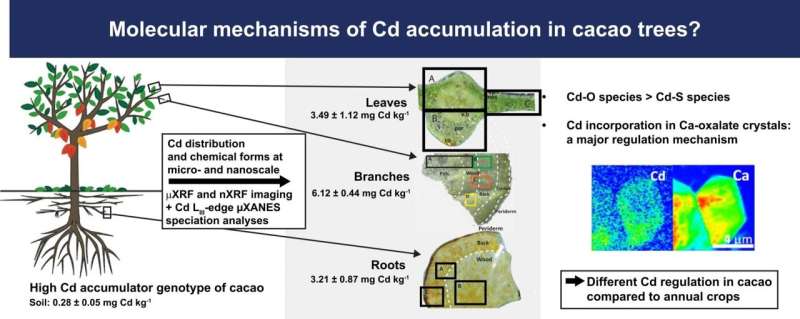This article has been reviewed according to Science X's editorial process and policies. Editors have highlighted the following attributes while ensuring the content's credibility:
fact-checked
trusted source
proofread
Cacao plants' defense against toxic cadmium unveiled

Researchers from the University Grenoble Alpes (UGA), France, together with the ESRF, the European Synchrotron located in Grenoble, France, used ESRF's bright X-rays to unveil how cacao trees protect themselves from toxic metal cadmium. This knowledge is relevant as new EU regulations restrict cadmium concentration in chocolate. Their results are published in Environmental and Experimental Botany.
Cadmium often accumulates in food, but it is a highly toxic metal, which can be harmful to humans if chronically exposed to it, according to the Food and Agricultural Organization. The EU has imposed limits to the cadmium maximal concentration in foodstuffs such as rice, wheat, potatoes, and, more recently, chocolate.
While there have been studies on how cadmium is transferred from soil to the edible part of stable crops, there is hardly any research on cadmium in cacao cultivars. "Understanding how cadmium builds up in cacao trees is paramount to subsequently find strategies to mitigate the accumulation of this metal in the final product," explains Geraldine Sarret, a researcher at the University Grenoble Alpes (UGA) and co-corresponding author of the publication.
The UGA scientists traveled to the International Cocoa Genebank in Trinidad and Tobago, which hosts a field cacao collection with approximately 2400 cacao genotypes, to collect their samples in collaboration with the Cocoa Research Centre.
Then they came to the ESRF, the European Synchrotron, located in Grenoble, France, to investigate a particular cacao cultivar/variety that absorbs more cadmium than others do. Using synchrotron techniques—nano X-ray fluorescence on ESRF beamline ID16B and X-ray absorption on ID21—they delved into the micro and nanoscale composition of the different parts of the plant.
"Thanks to the ESRF, we could map the presence of cadmium and other elements in an unprecedented resolution, so we could see the big picture but also go to the smallest detail," says Hester Blommaert, a Ph.D. student at UGA and co-corresponding author of the publication.
"The concentration of cadmium in the different parts of the plant is very low, so much so that we couldn't have done this research before EBS," says Hiram Castillo-Michel, a researcher at the ID21 beamline at the ESRF. "In the near future, we will see an increasing number of studies on similar food safety topics at ID21, where our recently installed new microscope will offer enhanced resolution and detection limits," he adds.
The results yield a surprise: "We found that part of the cadmium is stored in calcium oxalate crystals in roots and branches of the cacao plant, which was unexpected," explains Blommaert. In particular, the crystals were most abundant in the branches. Interestingly, while crystals were present in the leaves, they did not seem to help in detoxifying cadmium in this part of the plant. "We believe that the calcium oxalate crystals are a mechanism of detoxification of the plant against the metal."
In addition, they also discovered that cadmium combines with sulfur in certain cells in the roots. This mechanism is well known in the roots of cereals, where cadmium is retained in the vacuoles and bound to thiol-containing molecules. In the case of cacao, this mechanism is less pronounced, and more cadmium is transferred to aerial parts.
Overall, the strategy developed by cacao plants to manage cadmium is different from cereals in terms of root-to-shoot transfer, storage compartments, and storage forms.
"This new knowledge is a prerequisite for the selection or breeding of cacao cultivars accumulating less cadmium, and support a safe cacao production in South America," says Sarret. "However, we need to continue our studies, using other types of cacao plants and in different environmental conditions, to be able to design more precise strategies."
More information: Hester Blommaert et al, Ca-oxalate crystals are involved in cadmium storage in a high Cd accumulating cultivar of cacao, Environmental and Experimental Botany (2024). DOI: 10.1016/j.envexpbot.2024.105713
Provided by European Synchrotron Radiation Facility




















